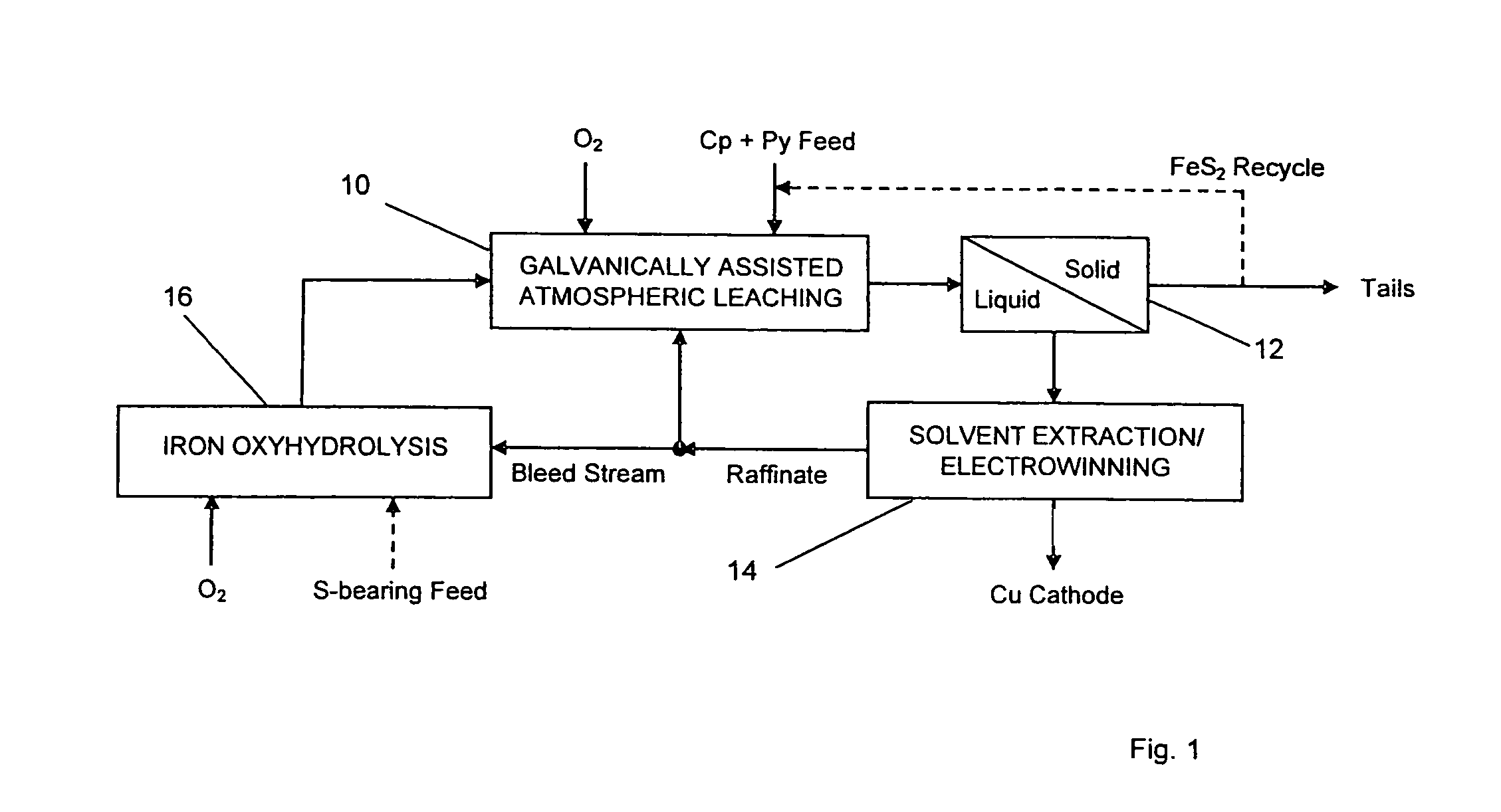Leaching process for copper concentrates
a technology of concentrates and copper, applied in the field of leaching copper, can solve the problems of passivating of the surface of chalcopyrite minerals
- Summary
- Abstract
- Description
- Claims
- Application Information
AI Technical Summary
Benefits of technology
Problems solved by technology
Method used
Image
Examples
example 1
Effect of Pyrite
[0049]As shown in FIGS. 2(a) and (b), pyrite has a significant effect on the ultimate recovery of copper from chalcopyrite. In this particular instance, a chalcopyrite:pyrite ratio of 1:4 ensures complete copper recovery in about 24 hours under the baseline conditions, while only about 50% of the copper is recovered in the absence of pyrite before leaching ceases entirely. Even though the test with pyrite started at a significantly higher potential, the presence of pyrite quickly pulled the potential to a level well below the other test and held it there for the duration. No other form of potential control was required.
example 2
Effect of Particle Size and Initial Solution Potential
[0050]The results of tests comparing the effects of particle size and initial solution potential are shown in FIGS. 3(a) and (b). These five tests were all run under the baseline conditions with the same amounts of the same minerals. Hence, they offer the clearest comparison of the effects of particle size.
[0051]These tests show that the particle size of the pyrite has a much more significant effect than that of the chalcopyrite. In every case, copper recovery decreases with increasing pyrite particle size. However, comparing the third (coarse-grind chalcopyrite—medium-grind pyrite) and fourth (medium-grind chalcopyrite—medium-grind pyrite) curves, we see that decreasing the chalcopyrite particle size without also decreasing the pyrite particle size has a detrimental effect on copper conversion. This result is completely at odds with conventional wisdom regarding the effect of chalcopyrite particle size on leaching efficacy (wher...
example 3
Effect of Pyrite Source
[0053]The effect of the source of the pyrite is shown in FIGS. 5(a) and (b). (Those tests using “Peru” pyrite are shown with open symbols, and those using “Utah” pyrite are shown with filled symbols.)
[0054]Comparing the two tests with square symbols, it makes very little difference which pyrite is used (although the “Peru” test used fine-grind chalcopyrite while the “Utah” test used medium-grind chalcopyrite). However, comparing the two tests with triangular symbols, the “Peru” pyrite seems to have outperformed the “Utah” pyrite. Indeed, the test involving the latter exhibited a lag period at the beginning during which the solution potential dipped to very low levels (almost down to 300 mV). However, after this initial episode, its performance was very similar to the other tests. It may be that there was a certain proportion of marcasite or pyrrhotite in the “Utah” sample which was subject to oxidation initially. In any case, the problem was eliminated by star...
PUM
| Property | Measurement | Unit |
|---|---|---|
| particle size | aaaaa | aaaaa |
| particle size | aaaaa | aaaaa |
| particle size | aaaaa | aaaaa |
Abstract
Description
Claims
Application Information
 Login to View More
Login to View More - R&D
- Intellectual Property
- Life Sciences
- Materials
- Tech Scout
- Unparalleled Data Quality
- Higher Quality Content
- 60% Fewer Hallucinations
Browse by: Latest US Patents, China's latest patents, Technical Efficacy Thesaurus, Application Domain, Technology Topic, Popular Technical Reports.
© 2025 PatSnap. All rights reserved.Legal|Privacy policy|Modern Slavery Act Transparency Statement|Sitemap|About US| Contact US: help@patsnap.com



